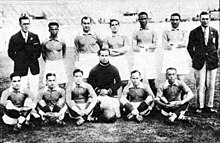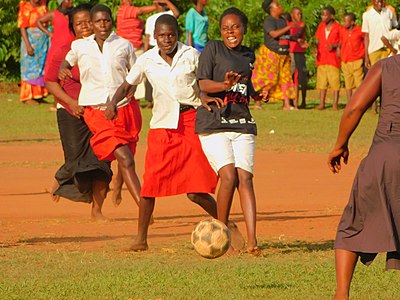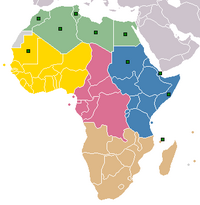Portal:Football in Africa
Introduction
Football is the most popular sport in Africa. Indeed, football is probably the most popular sport in every African country, although rugby and cricket are also very popular in South Africa. (Full article...)
This section may be unbalanced towards certain viewpoints. (October 2022) |

Selected article -
Al-Merrikh Sporting Club (Arabic: نادي المريخ الرياضي) is a Sudanese professional football club based in the city of Omdurman. Their home stadium is Al-Merrikh Stadium, which is locally known as The Red Castle. Founded in 1908, Al-Merrikh is one of the oldest football clubs in Africa. They have won the Sudan Premier League 22 times and Sudan Cup 26 times. The club has a fierce rivalry with Al-Hilal with the games between them regularly selling out, as well as being the only other realistic challenger to the league crown. They won the Om-al-Dahab championship in 1965 and are the only team to have ever won this one time event. Al-Hilal is also based in Omdurman with only Al-Ardha Street separating the teams. Between them they are Sudan's most powerful and successful football clubs.
Selected biography -
Milla achieved international stardom at 38 years old, an age at which most forward-playing footballers have retired, by scoring four goals at the 1990 FIFA World Cup. He helped Cameroon become the first African team to reach the World Cup quarter-finals. Four years later, at the age of 42, he became the oldest goalscorer in World Cup history by scoring against Russia in the 1994 FIFA World Cup.
Milla is also remembered for his trademark goal celebration of running to the corner flag and performing a dance. In the years that have followed, he has been recognised as a pioneer of the many unconventional and imaginative goal celebrations seen since then. He was named one of the 125 greatest living football players in 2004 by Brazilian football player Pelé. In 2007, he was named by the Confederation of African Football as the best African player of the previous 50 years.
Selected image -
 |
This is a football match between women and girls in Muguluka, Jinja, Uganda during the Women's Day Celebration event. The women beat the girls 1-0.
Subcategories
Related portals
More sports portals
WikiProjects
Related task forces and sub-projects
African football task force
WikiProject Africa • WikiProject Football
WikiProject Football task forces and sub-projects
 | |
| Wikipedia ads | file info – #250 |
Topics
Open tasks

- Expand stubs: Competitions in Africa • Organizations
- Expand club articles of teams from Africa.
- Expand biographies of Africans involved in football.
- Create: Requested articles • Most wanted football articles • Requested general football articles
- Add: Infoboxes • Images (General requests, Requested images of people)
- Review: articles currently under review
- Assess: Assessment requests • Assess an article
- Revert vandalism on this portal and on African football articles
- Assist in maintaining this portal and keeping its selected content up to date.
- WikiNews: Create and submit news stories about African football for Wikipedia's sister project WikiNews.
Associated Wikimedia
The following Wikimedia Foundation sister projects provide more on this subject:
-
Commons
Free media repository -
Wikibooks
Free textbooks and manuals -
Wikidata
Free knowledge base -
Wikinews
Free-content news -
Wikiquote
Collection of quotations -
Wikisource
Free-content library -
Wikiversity
Free learning tools -
Wiktionary
Dictionary and thesaurus
More portals
Sources

- ^ "The History Of Soccer In Africa". NPR.org. 2010-06-09. Retrieved 2016-03-31.
- ^ a b c Alegi, Peter (2010). African Soccerscapes. Ohio University Press. pp. 1–2. ISBN 9780896802780.
- ^ Frimpong, Enoch Darfah. "Ghana news: A world of superstition, frustration and disillusionment - Graphic Online". Retrieved 23 September 2017.
- ^ Lacey, Marc (8 August 2002). "Kangemi Journal; For Spellbinding Soccer, the Juju Man's on the Ball". The New York Times. NY Times. Retrieved 2016-03-31.
- ^ "World Cup Witchcraft: Africa Teams Turn to Magic for Aid". National Geographic. Archived from the original on July 10, 2006. Retrieved 2016-03-31.
- ^ Andy Mitten (September 2010). The Rough Guide to Cult Football. Rough Guides UK. ISBN 9781405387965. Retrieved 2016-04-02.
- ^ "African Nations Cup overshadowed by hocus pocus | Football". The Guardian. Retrieved 2016-04-09.
- ^ Kuper, Simon (2006). Soccer Against the Enemy: How the World's Most Popular Sport Starts and Stops Wars, Fuels Revolutions, and Keeps Dictators in Power. Nation Books. p. 123. ISBN 978-1-56025-878-0.


























